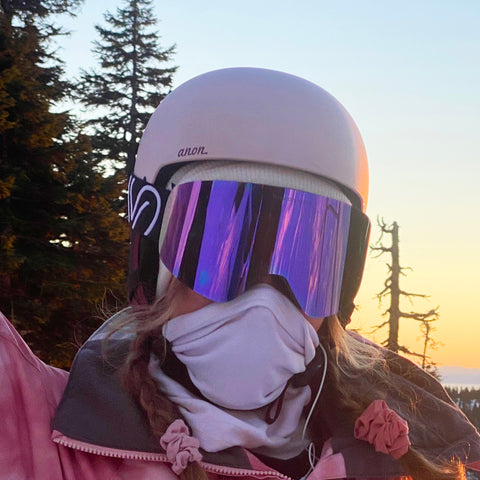How to Choose Goggles for Skiing and Snowboarding
Getting ready for a ski or snowboarding trip is exciting. And if you don’t have a pair of goggles you’re going to need some. These are probably the most important pieces of ski & snowboard equipment that you’ll need.

There are lots of things that you'll need to take into consideration when looking for a pair of ski and snowboard goggles. There are plenty of key features such as lens type, lens color/tint, interchangeable lenses, frame size, and fit. You’ll want to find the right fit for you. Here are some of the other things that you’ll want to factor into your purchase,
UV Protection
Nearly all new goggles, will have 100% UV protection, but you should never assume that they do. UV protection is especially important when you are on the slopes. The intensity increases with altitude, meaning that the harmful UV is strong even though it's winter.
Mirrored Lenses
The coating on the outside of the goggle that lenses mirrored helps to reflect much more light than a non-mirrored lens. The less light that you let in the less glare and increased visual clarity in bright conditions. While you might feel like Tom Cruise in Top Gun when wearing them, you’re going to want to take them off when you walk inside. It’s going to be difficult to see inside when you have these on. Mirror lens ski goggles are a great choice for sunny days.
Polarized Lenses
The light gets reflected off certain surfaces and it becomes a higher intensity through angles. Polarized lenses filter the vertical light and reduce the glare much better than the standard mirrored lenses. They even increase contrast and definition for better visual clarity. This is important when on the slopes you want to be able to identify ice and other potential dangers.
Double Lenses
If you’re goggles fog up often then a double lens will fix that problem. The double lens creates a thermal barrier that reduces fogging much better than a single lens. Most goggles will have double lenses but you always want to be sure.
Anti-Fog Coating
Fogging can be annoying and potentially dangerous when skiing down the slopes. A hydrophilic chemical treatment is used on the inside of the lenses to help significantly reduce fog. However, not all coatings are created equal. You’ll want to make sure that you’re reading the manufacturers’ directions to ensure that you do not wipe off the anti-fog coating.
Photochromic Lenses
These lenses will automatically adjust to a change in light conditions. They will get darker when the UV light is stronger and they will lighten when there is less UV light. This is a great advantage because it makes them extremely versatile. But the downside to them is that they don’t adjust instantly. It often takes them a few minutes to change with the light changes.

Why do skiers and snowboarders wear goggles?
When you’re at high altitudes you are exposed to different elements such as thinner air, and increased UV rays and the sun's reflection off the snow is much more intense. This is why wearing goggles is so important. Plus when you're whipping down the slopes the wind will make your eyes tear and blur your vision or you can get ice particles or twigs in your eye if you’re not protecting your eyes.
Ski goggles and snowboard goggles make your trip much more enjoyable.
Is there a difference between ski and snowboard goggles?
Goggles no matter if they are for snowboarding or skiing are designed to protect you from the cold and wind. There aren’t any differences between them.
Types of Ski & Snowboard Goggle Lenses
When looking at the different goggle lenses there are a couple of important aspects you’ll want to consider in order to find the right lenses. There are two different types of lenses for goggles - cylindrical and spherical.
Cylindrical Lenses, also known as Flat
The curve in this type of lens is horizontal but is flat vertically, hence the name flat lense. While cylindrical lenses provide decent performance at a much lower price point they don’t improve your vision much.
Spherical Lenses
Spherical goggle lenses curve both horizontally and vertically around your face. This is that bubbled look that you see when people are wearing goggles. They provide a significant amount of benefits such as better peripheral vision, reduced glare, less fogging, and less distortion.
What is VLT lens?
VLT is important when it comes to protecting your eyes from the light. It is the amount of light that passes through the goggle lens, Visible Light Transmission (VLT), and this is expressed through a percentage between 0% and 100%. Depending on the percentage of the VLT for a specific lens will determine how much light will pass through the lens.
What is the best VLT for skiing and snowboarding?
There are some lenses that are designed to perform better in low light and low visibility situations. The best ski & snowboard goggles VLT percentage for low light will range from 60-90%.
But for sunny days with high visibility, you’ll need to keep more light out and you’ll want to use a lower VLT percentage that ranges from 5-20%. Choosing a dark color lense of black, grey, and gold, and are often mirrored and keep the light out much better.
Of course, you never know what the day will bring low light or lots of sun so choosing a lens in the middle of the spectrum will be best for all conditions and the changing light conditions throughout the day.
How do I choose skiing and snowboard goggles?
Goggles should fit your face snugly and comfortably without being tight. There are some models that are better suited for smaller or larger faces. And plenty of choices for women and kids.
When choosing frames you’ll want to choose those made of polyurethane. They provide more flexibility and are best for cold temperatures.
Here are some other things to consider:
What color lens is best for snowboarding?
Choosing the wrong color lens can put you in a potentially dangerous situation. There is nothing worse than being blinded by the sun when you are flying down the slopes or having cloudy vision. There are dozens of lens colors for you to choose and each color will filter light differently. The color lens offers unique advantages in certain weather and light conditions and the most common choice for ski and snow goggles is gray. This is the most suitable choice for most conditions. Clear lens snowboard goggles are the best ski goggles for night skiing.
How to know size of snow goggles
There are plenty of things that you’ll want to take into consideration when purchasing snow goggles. snowboard goggles come in different sizes for different shaped and sized faces, and even options for choosing goggles over or under helmet.
Helmet compatibility: All goggles are going to be compatible with a helmet, but there are some helmets that go with certain types of snow goggles, this will ensure a comfortable fit.
Strap adjustments: You’ll want to make sure that the goggles have the ability to make adjustments. Ski goggle straps ensure that you’ll get the tight fit that you need. While most snow goggles do come with adjustments there are others that do not. It’s not always easy to find a pair of goggles for small face, so straps will help and increase your chances of finding the best ski goggles for small faces.
Padding: The padding helps to keep the goggle from pinching your face and provides comfort. You’ll want to make sure the foam is thick enough to cushion your face but not too thick that it will cause them to fog. Generally, goggles may 2 or 3 layers of thin padding to enhance venting.
OTG (Over the Glass) styles: This feature allows those of you who wear glasses to have goggles that fit over your glasses by providing the necessary space to avoid pressure on your temples and nosepiece.
ShadyVEU has a great selection for women snowboarding goggles and a ton of snowboard goggles mens styles. So whether you're looking for UVB goggles or frameless snowboard goggles they’ll have options.







Leave a comment